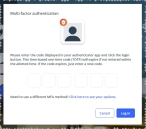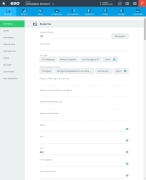Record mileage or hours traveled
You need to record the mileage traveled by a ground unit, or hours traveled by a water or air unit, during the incident response. This information is useful in anticipating unit maintenance needs and how far a patient had to travel to receive appropriate medical care.
When you enter the addresses of the incident scene and patient destination in the Scene and Destination sections of the Incident tab, the EHR module provides the option to calculate the mileage for you. You also have the option to enter mileage manually, if your route does not match the calculated mileage is based on.
-
 (If you have not done so already) Access the EHR module in the ESO Suite.
(If you have not done so already) Access the EHR module in the ESO Suite.
-
Do one of the following.
-
(If you are already working in the ESO Suite) Click the Home icon in the upper left corner of the screen.
-
 (If you have not yet logged in) Log in to the ESO Suite.
(If you have not yet logged in) Log in to the ESO Suite.
-
In a web browser, go to https://www.esosuite.net/EsoSuite.
The ESO Suite login screen appears.
-
Enter your user name, password, and agency name, then click Let's Go.
If MFA is enabled, the Multi-factor authentication dialog box appears, displaying one or more methods you can use to verify your login credentials. The number of methods that appear in the dialog box depends on what MFA methods your ESO Suite administrators enabled in the Admin module.

Click graphics
to open them.Information on enabling MFA and specific MFA methods is available in the Admin module online help, in Configure multiple-factor authentication.
Note: If your ESO Suite administrators have disabled MFA ("opted-out"), this dialog does not appear.
-
(If the Multi-factor authentication dialog box appears) Depending on which buttons appear in the dialog box, verify your login in one of the following ways.
 With an authenticator application.
With an authenticator application.
-
Click MFA verification via authenticator app.
The dialog box updates with boxes for entering the numbers of the authentication code, and the ESO Suite sends an authentication code to the authenticator application installed on your device.
-
Open your authenticator application and note the authentication code currently displayed.
-
Enter the authentication code displayed in the authenticator application.
-
Click Log In.
 With a text message (SMS).
With a text message (SMS).
-
Click MFA verification via SMS.
The dialog box updates with boxes for entering the numbers of the authentication code, and the ESO Suite sends an authentication code to the phone number recorded in your PM records and identified with MFA codes.
-
Enter the authentication code sent to your MFA-registered phone number.
-
Click Log In.
 With an email message.
With an email message.
-
Click MFA verification via email.
The dialog box updates with boxes for entering the numbers of the authentication code, and the ESO Suite sends an authentication code to your agency or department email address, recorded in your PM records.
-
Enter the authentication code sent to your agency or department email address.
-
Click Log In.
-
-
The ESO Suite landing screen appears.

Click graphics
to open them.Note: If MFA is enabled, you can access and manage your MFA options through the PM module, on the Settings > Account page, as described in Manage a user account. If your agency or department has enabled MFA but has not purchased the full-featured version of the PM module, you can access your own MFA settings by clicking Change my Multi-Factor Authentication settings on the landing screen, then using the Settings > Account page that appears. If your agency has not enabled MFA, the Change my Multi-Factor Authentication settings link does not appear on the landing screen.
-
-
On the top side of the home screen, click EHR.
Tip: If your screen or browser window is too narrow to display all your agency's ESO Suite module icons, an options icon appears on the right side of the icon bar. If you click the options icon, a menu appears containing additional module icons.
The EHR screen appears, displaying a list of patient records in the EHR module. The most-recent records appear at the top of the list.
Different record status icons can appear in the list.
Icon Status Unlocked/DraftThe patient record exists in the ESO Suite database, and all crew members listed in the patient record may edit all fields in the record. ESO Suite administrators and personnel with security roles of either
EHR SupervisororEHR Managercan edit non-clinical fields.MobileThe patient record exists on the mobile device, and has not been synchronized with the ESO Suite database. ESO Suite administrators, personnel with security roles of either
EHR SupervisororEHR Manager, and all crew members listed in the patient record can only access a print view of the record.Once the Mobile record synchronizes with the ESO Suite database. the record reflects its current status.
LockedThe patient record exists in the ESO Suite database, and is locked. Only non-clinical fields can be edited by crew members listed in the patient record, ESO Suite administrators and personnel with security roles of either
EHR SupervisororEHR Manager.
-
-
 (If you have not done so already) Add a new patient record, or search for the existing patient record you want to work with.
(If you have not done so already) Add a new patient record, or search for the existing patient record you want to work with.
Information on adding or opening a patient record is available in Add a patient record and Search for a patient record.
The patient record opens and displays the Incident tab, with the Response bookmark selected in the left pane. Fields appear in the right pane for specifying basic information about the incident
If you manually created a new patient record, the Incident Number and State Tracking Number fields populate automatically with ESO Suite-assigned values. You must enter data in all other required fields.
If you imported data from a CAD system, the Incident Number field populates with the data from that source. Other fields in the EHR module may also populate from these sources, depending on what data was recorded in them before the data was imported into the EHR module.
-
In the left pane, click the Mileage bookmark.
The right pane scrolls down to the top of the Mileage section of the page.
-
Do one of the following.
 Let the EHR module calculate loaded mileage or hours.
Let the EHR module calculate loaded mileage or hours.
Note: You must specify the addresses of the incident scene and patient destination in the Scene and Destination sections to use this feature.
-
In the map, click Calculate Mileage.
The map updates to display the scene and destination location markers, and the Scene, Destination, and Loaded Mileage fields populate with values calculated by Google maps.
If the Start and/or Finish fields appear, you can also enter values for them as described in Manually specify mileage or hours. If you specify both values, the EHR module calculates the value for Total Mileage based in the start and finish values.
Note: These fields appears in the EHR module only if your ESO Suite administrator enabled them in the Admin module, under EHR > Incidents Tab > Configurable fields.
Information on enabling EHR fields is available in the Admin module online help, in Configure tabs.
 Manually specify mileage or hours.
Manually specify mileage or hours.
Total mileage is the distance (ground units) or hours (water or air units) from the dispatch (starting) location of the unit to the final location of the unit after the incident. Loaded mileage is the distance from the incident scene to the patient destination is the loaded mileage, carrying the patient.
Note: If the EMS vehicle or unit is designed for water or air (fixed wing or rotor craft) travel, specify values in the fields below as an hours counter reading instead of an odometer reading.
-
For each of the following fields, click the number pad icon to the right of the field, then enter the appropriate numerical values from the number pad dialog box that appears.
Note: Any field below marked with (Admin-enabled) appears only if it was enabled in the ESOAdmin module by an ESO Suite user with the necessary permissions to configure the EHR module.
Information on enabling EHR fields is available in the Admin module online help, in Configure tabs.
For this field Specify this Start
(Admin-enabled)
The odometer or hours reading of the unit at the beginning of the call (when the unit begins moving).
Scene
The odometer or hours reading of the unit when it arrives at the scene.
Destination
The odometer or hours reading of the unit when it arrives at the destination.
Finish
(Admin-enabled)
The odometer or hours reading of the unit when the unit it back in service.
If using a counter, this is the mileage traveled beginning with dispatch through the transport of the patient to their destination and ending when back in service, starting from 0.
The Loaded Mileage and Total Mileage fields populate with values calculated from the mileage or hours you entered.
-










